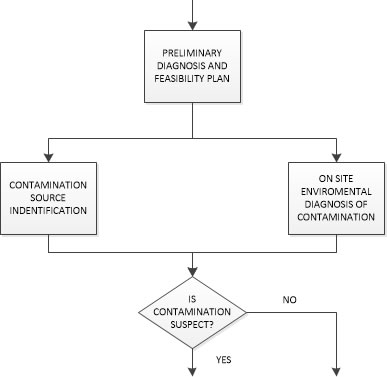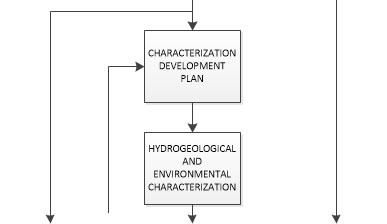SOIL RECOVERY 2 OIL - CONTAMINATION CLEANUP
For all your soil cleanup needs, SR2O can evaluate large hydrocarbon contamination sites for a proper solution.Phase I – Contamination Analysis from Client
In this phase, alI information and data relating to the suspect site are collected, including the following:
– plans and information about the existing facilities and equipment;
– data and information about soil pollution potential sources;
– history of soil contamination and spills;
– geological and hydrogeological information available.

Phase II – Preliminary Diagnosis and Feasibility Plan
Based on the initial data obtained, field work planning is carried out considering:
– specifications of field tests, assessments and studies:
– detailed schedule:
– material and human resources;
– logistics:
– service contracting.

Phase III – Characterization Development Plan
First, the work necessary to characterize the contamination is planned. The planning stage includes the following:
– specifications for soundings, tests and geotechnical analysis;
– specifications for environmental assessments;
– specifications of procedures for drilling and sample collection;
– material and human resources;
– logistics;
– service contracting.
The contamination characterization plan is executed through the development of two parallel activities:
Hydrogeological characterization – by using geological and hydrogeological data available, regional maps of soil use and the information obtained
from drilling on the site, the following data must be obtained:
– description of soil layers;
– data on the size of grains and hydraulic conductivity;
– direction of the freatic aquifer flow;
– use of the are a groundwater and soil.
Environmental characterization – mapping and definition of the contamination plume, which are done through the following activities:
– implementation of a monitoring wells network in the freatic aquifer;
– evaluation of phases: (i) free, by means of collection and visual examination of groundwater samples; (ii) retained, by means of collection and chemical
analysis of subsoil gases, or collection and chemical analysis of the soil; (iii) dissolved, by means of collection and chemical analysis of groundwater;
– isoconcentration maps tracing;
– evaluation of the contamination plume direction.

Phase IV – Control Measures
The decision on the need for soil or groundwater recovery measures is based on the international standards mentioned earlier and on assessments of
potential environmental risks of the contamination for human health or ecosystems.
Therefore, the pollutant’s concentration is calculated in the soil, water, air and plants. Models of massive means of transportation are used to sirou1ate
the contamination movement. The exposure evaluation must include the following:
– soil ingestion;
– ingestion of contaminated food;
– ingestion of the water supplied;
– inhalation of particulate vapor and materials;
– skin contact with contaminated materials.
The standard values are defined based on hypothetical exposure ways of each receptor, for several soil use scenarios.
If there is need for control measures, a recovery plan is prepared for the area, considering the following:
– sanitation technology;
– sanitation limit-levels;
– implementation schedule;
– methods to dispose of contaminated materials that may be found in the area;
– sanitation monitoring plan;
– remediation alternatives to minimize the impact on receptors.

Information Request Form
Frequently Asked Questions
Usually questions become very specific to the nature of your municipality’s needs within a conversation. Our FAQ’s questions are simple and are in the top generic questions asked to SR2O.
If you have any questions, comments or needs for your local area, please feel free to contact us.
What type of clients do you work with?
SR2O Establishes our own facilities in areas that we have specifically chosen based upon our knowledge of feedstock. However, we have been approached by City municipalities, County and State agencies about our solutions. We have various methodologies in bringing our technology to your local area along with options for financing a solution that fits your City, County or State.
What is Development time?
Depending upon where you are at in your local development process, and the data available or gathered, SR2O typically sees an 18-24 development cycle to operations of a facility.
Do you have an affiliate program?
At this point and time we do not have anyone except ourselves representing SR2O, or our subsidiary company’s.